|
 Secure Site
Secure Site
|
 |
Archive for the 'Meditation Tools' Category
 Meditation made easy Basic Breath Meditation
What is it?
The cornerstone of all meditation techniques, this practice centers on something we always do but rarely notice: breathing. “You do not have to do anything with your breath but observe it,” says yoga and meditation teacher Rosen. Eventually, you can work on changing your breath, and sending it into new areas of your torso. But at first, just become aware of each inhalation and exhalation; let your mind track how the breath moves, mapping where it goes to develop an understanding of your own unique “breathing identity.”
What’s it good for?
Use this meditation to get centered anytime and anywhere. “You can retreat into your breath whenever you’re feeling dull, tired or stressed out,” says Rosen.
How long does it take?
Start with 10 minutes at first, then work your way up to 15 and finally 20 minutes.
How do I do it?
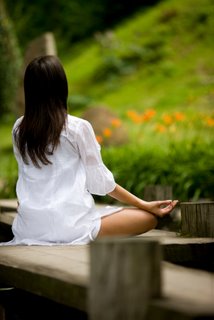 Meditation 1. Sit in a comfortable position with your legs crossed. Or lie on your back with your body straight and a firm pillow or rolled-up towel under your knees. Your arms should rest about 45 degrees from your torso.
2. Breathe quietly in and out through your nose. Feel each breath as it moves through your torso. Feel where in your body the breath is moving and where it is not.
3. Begin to notice how your breath changes as you focus on it, and how your awareness changes in turn. (Rosen likens this process to a feedback loop between the breath and “the witness,” who’s observing it.)
4. When your mind begins to drift, gently bring it back to your breath.
5. Begin to bring your breath into areas of your body that feel dull or “un-breathed.” Imagine your torso as a container, and try actively sending breath into the places it’s not reaching, such as your pelvis or the small of your back. Don’t force the breath, just allow it to follow your consciousness.
6. At the end of your session, wiggle your fingers and toes, then stretch your legs and arms. If you’re lying down, roll over to one side and pause before pushing up to a seated position. Roll up slowly, leading with your torso and raising your head last.
Use our unique “Zen Clock” which functions as a Yoga & Meditation Timer. It features a long-resonating acoustic chime that brings your meditation or yoga session to a gradual close, preserving the environment of stillness while also acting as an effective time signal. Our Yoga Timer & Clock can be programmed to chime at the end of the meditation or yoga session or periodically throughout the session as a kind of sonic yantra. The beauty and functionality of the Zen Clock/Timer makes it a meditation tool that can actually help you “make time” for meditation in your life. Bring yourself back to balance.
adapted from Naturalhealthmag.com By Frances Lefkowitz
Now & Zen – The Gong Meditation Timer Shop
1638 Pearl Street
Boulder, CO 80302
(800) 779-6383
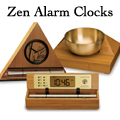 Meditation Timer with Gongs and Chimes 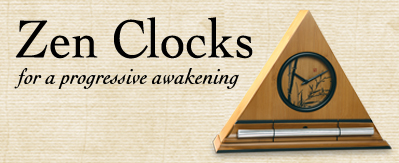 Meditation Timers and Alarm Clocks with Gentle Sounds
Posted in Meditation Timers, Meditation Tools, mindfulness practice
 Mindfulness Meditation Mindfulness Meditation
What is it?
“Mindfulness meditation is not about achieving bliss or tranquility,” explains Sharon Salzberg, co-founder of the Insight Meditation Society (dharma.org) in Barre, Mass. and author ofLovingkindness: The Revolutionary Art of Happiness (Shambhala). “Rather, its aim is to see things as they really are more clearly.”
What’s it good for?
Mindfulness meditation is a form of “mind training,” says Salzberg. Bringing direct awareness to drinking a cup of tea, for instance, means that you really feel the warmth of the cup in your hands, and really taste the sweetness or the bitterness in your mouth. This applies to our emotional states, too—observe with awareness and perceive more accurately what your experience really is.
How long does it take?
Start with five minutes daily. Gradually add a few minutes to your session each day until you can sit for 20 minutes.
How do I do it?
1. Sit in a comfortable position on a pillow, chair, couch or floor.
2. Listen to the sounds around you while you relax. Practice letting the sounds come and go without holding on to them or pushing them away.
3. As you inhale, think “in”; as you exhale, think “out.” Let this action be a kind of home base.
4. When your mind drifts and thoughts start to wander, pay attention to what comes up. You may be aware of a pain in your shoulder, for instance, or think of an argument from the night before. Acknowledge this thought or feeling, spend a moment with it and then bring your awareness gently back to your home base. Rather than rushing past the new sensations you experience, bring your full awareness to them.
5. If you find yourself getting stuck in an emotion or sensation, it may help to put a mental label on it, to identify it as “anger” or “pain.” Then bring your awareness back to your breath.
6. The traditional way to end this meditation is to acknowledge the positive energy you’ve created and to dedicate it to others. Try saying: “May the merit of this practice be dedicated to all beings everywhere.” Stand, and continue to practice mindfulness as much as you can throughout the day.
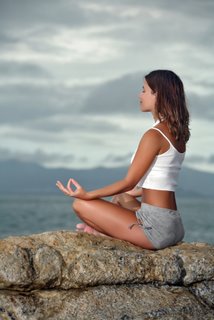 Mindfulness Practice - Meditation Use our unique “Zen Clock” which functions as a Yoga & Mindfulness Timer. It features a long-resonating acoustic chime that brings your meditation or yoga session to a gradual close, preserving the environment of stillness while also acting as an effective time signal. Our Yoga Timer & Clock can be programmed to chime at the end of the meditation or yoga session or periodically throughout the session as a kind of sonic yantra. The beauty and functionality of the Zen Clock/Timer makes it a meditation tool that can actually help you “make time” for meditation in your life. Bring yourself back to balance.
adapted from naturalhealthmag.com By Frances Lefkowitz
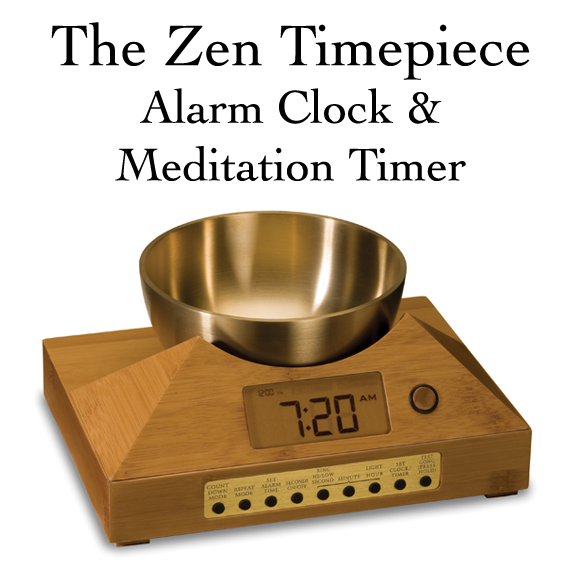 Mindfulness Meditation Timer and Alarm Clock with Gong Now & Zen – The Gong Meditation Timer Shop
1638 Pearl Street
Boulder, CO 80302
(800) 779-6383
Posted in Meditation Timers, Meditation Tools
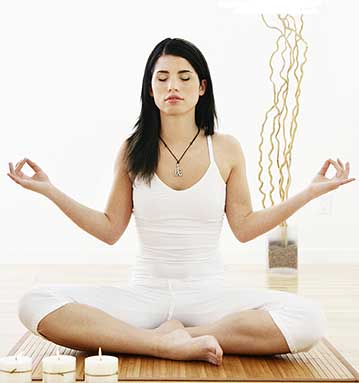 Meditation for Insomnia If you’re tossing and turning and having trouble getting a good night’s sleep, you may want to consider meditation, researchers suggest.
People with primary insomnia reported that they slept better after trying meditation, according to a new study to be presented June 9 at SLEEP, the annual meeting of the Associated Professional Sleep Societies, in Seattle.
Primary insomnia is described as difficulty getting to sleep or staying asleep over a time period of at least one month, according to the U.S. National Institutes of Health.
While most insomnia occurs along with another physical or mental illness or disorder, or as a side effect of medications or other substances, primary insomnia occurs on its own.
In the study, researchers divided 11 participants aged 25 to 45 with chronic primary insomnia into two groups. One group participated in Kriya Yoga — a form of meditation that helps an individual focus internalized attention and can reduce arousal — as well as health education.
The other group received information about improving health through exercise, nutrition, weight loss and stress management but did not participate in meditation.
After two months, the meditation group reported improvements in sleep quality, how long it took to get to sleep, total sleep time, total wake time, sleep efficiency and depression, the researchers reported.
Primary insomnia is believed to be a problem of hyperarousal, with high levels of arousal noted 24 hours a day, said lead study author Dr. Ramadevi Gourineni, director of the insomnia program at Northwestern Memorial Hospital in Evanston, Ill.
“Results of the study show that teaching deep relaxation techniques during the daytime can help improve sleep at night,” Gourineni said in a news release from the American Academy of Sleep Medicine.
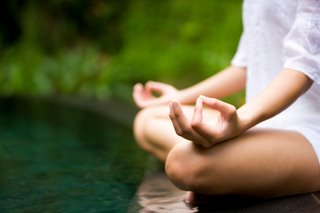 Meditation Pose for Insonmnia About 9.4 percent of U.S. residents, or an estimated 20 million people, try meditating during a 12-month period, according to a 2007 study by the National Center for Complementary and Alternative Medicine. People reported using meditation for various health problems, including anxiety, pain, depression, stress and insomnia.
A 2007 review of the scientific literature found some evidence that meditation is associated with health benefits, possibly by causing heart rate and breathing to slow, improving blood flow and reducing activity in the sympathetic nervous system (the body’s fight-or-flight mechanism).
Our unique “Zen Clock” features a long-resonating acoustic chime that brings the meditation session to a gradual close, preserving the environment of stillness while also acting as an effective time signal. The Digital Zen Clock can be programmed to chime at the end of the meditation session or periodically throughout the session as a kind of sonic yantra. The beauty and functionality of the Zen Clock/Timer makes it a meditation tool that can actually help you “make time” for meditation in your life.
More information
The National Center for Complementary and Alternative Medicine has more on meditation and health.
SOURCE: American Academy of Sleep Medicine, news release, June 9, 2009
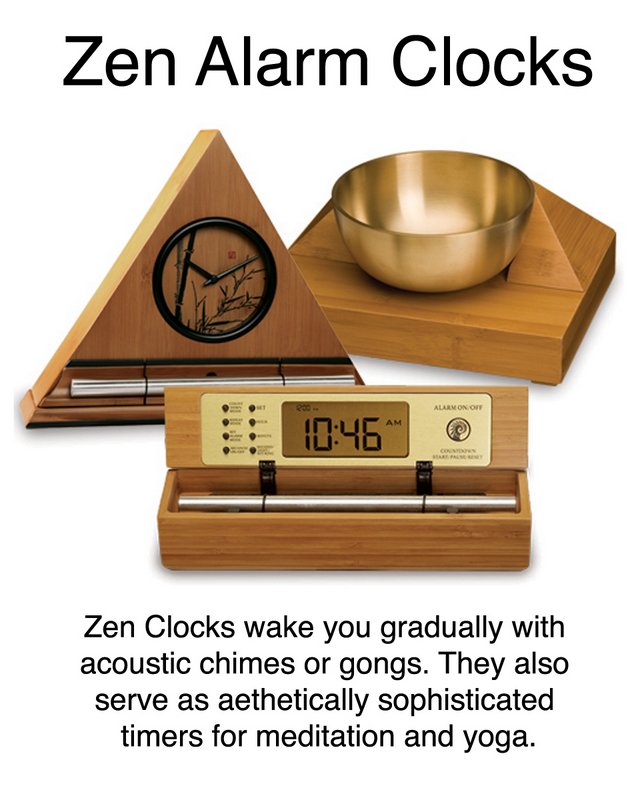 Practitioners usually employ a quiet, tranquil space, a meditation cushion or bench, and some kind of timing device to time the meditation session. Now & Zen – The Chime Meditation and Alarm Clock Shop
1638 Pearl Street
Boulder, CO 80302
(800) 779-6383
Posted in Meditation Timers, Meditation Tools, mindfulness practice
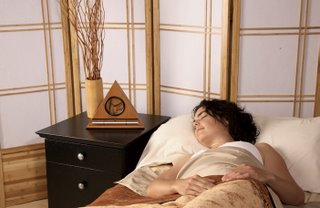 Sleep Issues Sleep Statistics
In 2008 the Centers for Disease Control and Prevention set out to learn just what determines how much sleep Americans get. The lowdown from the survey’s 403,981 respondents follows.
Women are more likely than men to get an insufficient amount of sleep. The results were 12.4 percent of women surveyed versus 9.9 percent of men.
Work helps you sleep. People who are employed get more rest than those who aren’t. But retirees get more sleep than either of those groups. (Only 9.5 percent of retired respondents reported not getting enough z’s.)
More education = more sleep. People with a college degree snooze more than those without a high school diploma or a GED.
Married and single people sleep roughly the same amount. But being divorced, widowed, or separated increases your likelihood of insufficient sleep.
Where you live affects your sleep. West Virginia has the highest rate of sleeplessness—more than 19 percent of respondents. For more sufficient sleep, head to North Dakota, where only 7.4 percent reported inadequate sleep.
The good news? The older you grow, the more likely you are to get enough sleep. People over the age of 65 reported the lowest percentage of insufficient sleep.
adapted from RealSimple.com
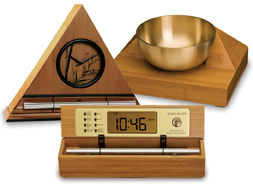 Zen Alarm Clocks Contribute to Good Sleep Habits Now & Zen Alarm Clock Store
1638 Pearl Street
Boulder, CO 80302
(800) 779-6383
Posted in Meditation Tools, mindfulness practice, Natural Awakening, sleep, Sleep Habits, wake up alarm clock
 Meeting Challenges with An Open Heart Reach deep, and find your own inner balance in the midst of crisis
Most of us understand about life being tough, and what it means to be, at least occasionally, on the losing side of things. The end of a relationship, standing helpless as loved ones suffer health problems, experiencing personal financial devastation, or even the grief of losing a job can be debilitating in their intensity, and staggering in their scope. Just switching on the news reveals that if we share nothing else as a world community, we share this one thing: No life is without its own, unique set of tests and troubles. Keeping an open heart in the midst of life’s challenges might be difficult, but it can also be a powerful tool for coping.
Success is not final, failure is not fatal: it is the courage to continue that counts. —Winston Churchill
Courage is easy to talk about, but where does it come from, and where do we find the ability to climb out of bed in the morning when the only thing that’s recognizable is the feeling of despair? Popular wisdom tells us that it’s not what life presents us that’s important, but the way in which we choose to respond. That may be perfectly true, but it doesn’t make it easy. Mariana Caplan, Ph.D., is a counselor, professor of yogic and transpersonal psychologies, and the author of seven books in the fields of psychology and spirituality, including Halfway Up the Mountain and To Touch is to Live (Hohm, 2002), and Eyes Wide Open: Cultivating Discernment on the Spiritual Path (Sounds True, 2009). Caplan, who has lived in villages in India, Central and South America, and Europe, holds degrees in cultural anthropology, counseling psychology, and contemporary spirituality, and has spent years researching and practicing the world’s great mystical traditions. She currently resides in the San Francisco Bay area and teaches at the California Institute of Integral Studies.
“There are many things we cannot control,” acknowledges Caplan, “but one thing we can control, or at least cultivate, is our attitude towards ourselves, our lives, and the situations that life presents. It is through the cultivation of discernment that we are able to have more choice not in terms of what life gives us, but whether we experience these things with gratitude and openness, or whether we fall into defeat.”
Not that this means that it’s an easy task, or that all hardships offer the same challenges. Losing a child, losing a job, and losing a home through foreclosure produce understandably different responses. The sudden illness of a family member or friend, or the diagnosis of a serious health condition of our own likewise elicits a whole host of reactions, and requires any number of considerations.
Respected retreat leader James Finley, Ph.D., and author, along with Carolyn Myss, of the learning course Transforming Trauma (Sounds True, 2009), suggests that in times of extreme difficulty, it’s essential to consider the details of what, exactly, is happening to us, and to accept that we’re very likely doing our best to understand and work through the situation. This, he explains, is the reality of crisis management—what are reality-based ways of understanding the moment, what are the options, and what can be done to provide the best possible outcome?
“We have to consider the impact of the event on our sense of security and identity,” says Finley. “The crisis or trauma has accessed us, and has threatened our sense of who we are. This is the interior dimension of the crisis. This has to do with understanding what trauma is—it’s the experience of being powerless. It’s important to establish a boundary between us, and what is being inflicted or is about to inflect harm. That applies to whatever the crisis is: a medical diagnosis, a relationship falling apart, or a natural disaster.”
The world is full of suffering, it is also full of overcoming it. —Helen Keller
Successfully transcending suffering, says Finley, requires moving toward our centers, and grounding ourselves in this space. This, he says, is where spirituality comes in. “Spirituality is a resource in healing,” he continues. “It helps us to stay grounded in the midst of the circumstances of life, and until you are grounded, you can’t effectively deal with the event. We may have to ride the waves of the storm, but it keeps our boat from tipping over. We might not be able to stop the storm, but maybe we can do something to stabilize ourselves, and ride it though.”
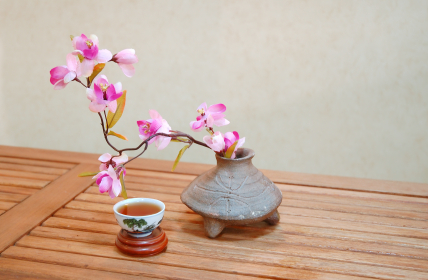 . Once you experience the Zen Timepiece's progressive tones, you'll never want to meditate any other way. It serves as the perfect meditation timer. First, says Finley, find what it is in your life that serves as your point of contact with the spiritual depth that transcends whatever is happening; the realization that inner peace is not dependent on external conditions. This is personal for each of us. For some, it might be religious faith. For others, it’s a guided program, a loved one, or nature.
“When we get afraid,” says Finley, “our hearts contract, our souls contract. Don’t panic. Pause. Reground yourself. Go to your point of contact to get your bearings. By practicing emotional sobriety, you don’t contribute to the situation in a negative way. Remember to tell yourself this: I’m nothing but the Self this is happening to. But I’m not JUST the Self that this is happening to.”
The second step is to have a spiritual practice. Finley defines this as any act habitually entered into with our whole hearts that serves as a way to keep ourselves grounded, and a way to transcend whatever is happening. If our point of contact is a loving relationship with another person, then our practice is to keep in touch with them. That doesn’t mean endless phone calls or visits. Carrying a photo of that person in our wallet, or keeping one on our desk, will suffice. It’s about keeping them firmly in our minds eye, and sustaining our consciousness of this person.
“If your pint of contact is nature, then your spiritual practice is to go out into the garden, or to keep plants in the house that you can nurture, or even to stop on the way home from work to walk in a park or another place where you can be surrounded by nature,” continues Finley. “If your point of contact is a spiritual teacher, then your practice might be to carry around a few words by them. All of these are points of meditation, and serve as ballast. We learn to ground ourselves this way, by taking part in a physical act. It takes fidelity to do this. Crisis is intense, but if we are sincere, we can slowly stabilize.” Third, we must accept that this groundedness in meditation in of itself does not solve the crisis. If a relationship is falling apart, a tornado has struck, or we’ve learned a loved one has a terminal disease, we are still left to face that reality. We ground ourselves as a resource from which to draw the courage to face whatever the catastrophe is. Crisis intervention includes acknowledging and validating the experience, not denying it or diminishing it.
“So, we ground ourselves at the level of the intensity of the pain,” Finley says. “Once we’re there, then we can move forward from that place. Too often, we get stuck in not just what happened to us, but what the thing that happened did to us.”
Pain is inevitable. Suffering is optional. —Anonymous
“Everybody experiences personal challenges in their lives,” agrees Caplan. “If not at the present moment, then in the future or in the past. I think we need to learn to constantly open to what we are given, to feel the feelings of it, to live it fully. We cultivate a trust in life, even when we don’t feel it, and we keep putting one foot in front of the other. Eventually, everything will change—it is just how things are.”
 Meditation It’s always easier, of course, to consider such things when our lives are humming along in relative harmony, our families are healthy, and our finances are secure. But challenges will come. Hopefully, we’ll discover when we come out on the other side of our experience, however difficult it was, that it wasn’t just painful, but that we have somehow been transformed by it. We may have learned to be more at peace, become more humble, or found a previously untapped inner wisdom. Maybe, by deepening our spiritual practices now, we’ll be that much more prepared should we suddenly be presented with a less happy state of affairs. Just as our bodies benefit from regular physical exercise, perhaps it’s also possible to strengthen and fortify our souls. It seems, at the very least, worth a try.
Use our unique “Zen Clock” which functions as a Yoga & Meditation Timer. It features a long-resonating acoustic chime that brings your meditation or yoga session to a gradual close, preserving the environment of stillness while also acting as an effective time signal. Our Yoga Timer & Clock can be programmed to chime at the end of the meditation or yoga session or periodically throughout the session as a kind of sonic yantra. The beauty and functionality of the Zen Clock/Timer makes it a meditation tool that can actually help you “make time” for meditation in your life. Bring yourself back to balance.
adapted from healinglifestyles.com By Debra Bokur
 It's exquisite sounds summon your consciousness out of your meditative state with a series of subtle gongs. Now & Zen – The Meditation Timer Shop
1638 Pearl Street
Boulder, CO 80302
(800) 779-6383
Posted in Meditation Timers, Meditation Tools
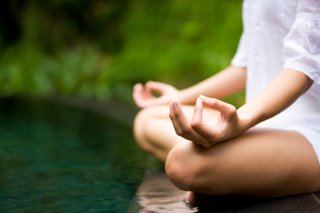 Meditation Problem: You are Tired All the Time
Culprit: Your Adrenal Glands
They’re responsible for secreting the fight-or-flight hormones adrenaline and cortisol, which surge as a response to stress—whether the prehistoric-days type, like being chased by a tiger, or the modern-day version, like financial worries or your mother-in-law. But when you’re feeling stressed all the time, those glands may become overworked and can tire out—a condition commonly called adrenal fatigue, says Keenan. The inability to secrete enough cortisol during the day can cause energy dips, then spikes at night that can interfere with restful sleep.
To give your adrenal glands a chance to recharge, Keenan recommends meditation, which she thinks of as parking the body in neutral. “Meditation has the effect of slowing down the production of cortisol for a while,” she says. Try sitting quietly and clearing your mind. Set your Zen Clock for at least five minutes a day and increase until you are able to sit comfortably for 20 minutes each day. Vitamins B5 and C have also been shown to support adrenal function, says Jacob Teitelbaum, the Kona, Hawaii–based medical director of the Fibromyalgia & Fatigue Centers and the author of From Fatigued to Fantastic!. He recommends getting at least 50 milligrams of B5 and 500 milligrams of C daily. Other stress-reduction techniques work well, too. “Exercise is particularly effective,” says Park.
adapted from RealSimple.com
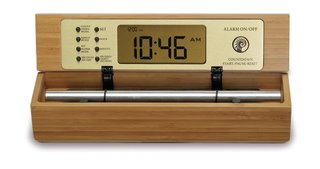 Meditation Tools and Timers by Now & Zen, Inc. Now & Zen Meditation Tool Store
1638 Pearl Street
Boulder, CO 80302
(800) 779-6383
Posted in Chime Alarm Clocks, intention, Meditation Timers, Meditation Tools, mindfulness practice
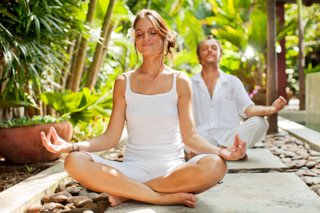 Once you experience the Zen Timepiece's progressive tones, you'll never want to meditate any other way. Cheap, low-tech stress relief may also protect against depression, insomnia, and anxiety
Meditation is no longer just for the groovy folk. A just published study in the American Journal of Hypertension suggests the practice may bring cardiovascular and mental-health benefits. The research, conducted at American University in Washington, followed 298 students, half of whom practiced transcendentalmeditation for 20 minutes once or twice daily over three months and half of whom did not. Results: A subgroup of subjects in the meditation group who were at increased risk for hypertension significantly lowered their blood pressure and psychological distress and also bolstered their coping ability. The average reduction in blood pressure in this group—a 6.3-mm Hg decrease in the top (systolic) number of a blood pressure reading and a 4-mm Hg decrease in the lower (diastolic) number, compared with the control group—was associated with a 52 percent reduction in the risk of developing hypertension in the future. Meditators who were not at increased risk for hypertension saw a reduction in psychological distress, depression, and anxiety as well as increased coping ability but no significant lowering of blood pressure. The results are particularly meaningful at a time when “improvement in mental health is of great concern as greater numbers of college students are being treated for anxiety and depression than ever before,” says lead study author, Sanford Nidich, professor of physiology and health at the Institute for Natural Medicine and Prevention at Maharishi University of Management in Iowa.
Lately, meditation has been garnering attention from a host of medical and scientific researchers. More than 120 meditation studies are listed on clinicaltrials.gov, a clearinghouse for research supported by the National Institutes of Health, investigating the intervention in patients with conditions from cancer and heart disease to post-traumatic stress disorder, insomnia, and binge eating. It’s no cure-all, but early research is suggesting meditation could play a helpful role in mediating the stress response that contributes to a number of physical and mental conditions.
In a country famous for medical innovation and high-tech treatments—not to mention their high cost—Americans, too, have begun to embrace complementary and alternative interventions like meditation, acupuncture, and “natural” supplements. According to a recent study sponsored by the NIH’s National Center for Complementary and Alternative Medicine, more than 1 in 3 adults sought such healthcare in 2007—and collectively spent $40 billion out of pocket. But with the exception of the classes, books, or CDs one might buy to learn the ins and outs of “om,” focusing on one’s breath, or becoming more mindful, the practice of meditation is free.
One simple thing seems clear: Find a type of meditation that you like. “What’s really important,” says Richard Davidson, neuroscience and meditation researcher at the University of Wisconsin-Madison,” is that a person find a particular style [of meditation] they’re comfortable with so they continue to practice.” Some styles train practitioners to focus on an object or a mantra; others cultivate positive emotions; others still aim to train practitioners not to judge thoughts that arise but to just accept them and not get attached. More meditation, it seems, offers stronger effects; Davidson’s research on monks who had practiced for tens of thousands of hours in their lifetimes managed to change their brains’ functioning and structure. Benefits appear to be attainable with less of a time commitment, he adds—perhaps somewhere between 20 and 40 minutes daily.
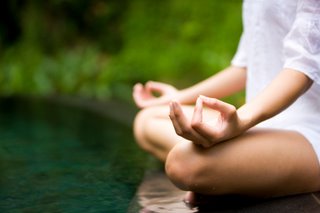 Meditation Pose Not all doctors have bought into the merits of meditation as a treatment, nor should they just yet. The hard research medical practitioners swear by is still in the early stages. The National Center for Complementary and Alternative Medicine is starting to fund needed research with larger sample sizes of participants and solid study design, says Jeffrey Greeson, meditation researcher and assistant clinical professor in the department of psychiatry and behavioral sciences at Duke University School of Medicine. He predicts that results will begin to emerge in the next five years. Meantime, based on some encouraging preliminary findings, here are five reasons a clinician hip to the importance of the mind-body connection may cite for prescribing meditation—and one reason she may choose not to.
By SARAH BALDAUF for US News

Now & Zen – The Meditation Timer Store
1638 Pearl Street
Boulder, CO 80302
(800) 779-6383
Posted in Meditation Tools
 Butterflies Plate #21, Natural History of Britain on the patio
the afternoon drifts along
with the butterfly.
– Patricia J. Machmiller
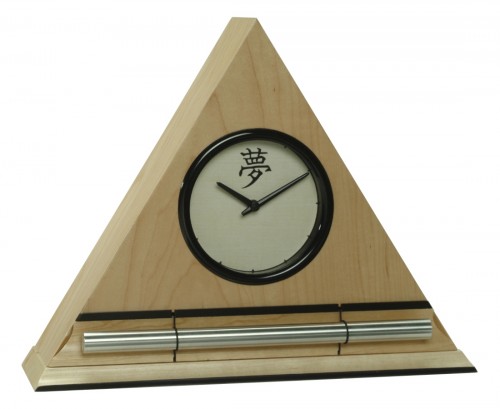 Maple Dream Kanji Zen Alarm Clock, progressive chime alarm clock
Now & Zen – The Zen Alarm Clock Store
1638 Pearl Street
Boulder, CO 80302
Posted in Beauty, Japanese Inspired Zen Clocks, Japanese Poetry, Meditation Timers, Meditation Tools, mindfulness practice, Now & Zen Alarm Clocks, Progressive Awakening
 time your walking meditation with the Digital Zen Timer by Now & Zen, Inc. Ways to Relive Stress:
Get rid of nervous tension by inhaling as you take four steps, then exhaling for four steps. Repeat for at least three minutes (the longer, the better). Work up to six to eight steps per inhale and exhale. Use your Digital Zen Timer on the ‘Repeat Mode’ so that it will chime every three minutes to time yourself.
Now & Zen Headquarter Store
1638 Pearl Street
Boulder, CO 80302
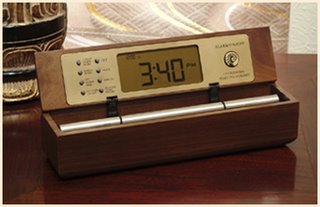 Timers and Alarms with Chimes
Posted in Chime Alarm Clocks, Meditation Timers, Meditation Tools, mindfulness practice, nature, Now & Zen Alarm Clocks, Yoga Timer, Zen Alarm Clock
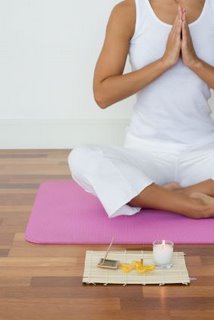 energizing yoga It’s three o’clock, and despite your novel-length to-do list, the only thing that holds your attention longer than 30 seconds is the thought of a caffeine or sugar fix. You’d get a better and more sustained boost, though, by practicing a midday meditation.
Typically associated with relaxation, meditation also jump-starts energy and clears a foggy head, says Eric Harrison, director of Australia’s Perth Meditation Centre and author of “Flip the Switch: 40 Anytime, Anywhere Meditations in 5 Minutes or Less.” “If you meditate consciously and don’t succumb to sleep, your mind becomes calm and clear,” he explains. And unlike the usual drowsiness cures, a few minutes of meditation can keep you alert all afternoon.
One of Harrison’s favorite quick meditations involves tuning in to the sounds we generally try to ignore, which gives the chattering mind a chance to rest. So close your office door or find a quiet space and follow these easy steps — and that cafe run might soon be a thing of the past.
 yoga at work Listening Meditation
Clear a space. Set your Zen Meditation Timer for 5 minutes. Take a moment to remove some of the clutter in your immediate area — mugs, scattered pens, loose papers. This helps you transition into meditation mode and sets the stage for a calmer, more productive afternoon.
Log off. Turn off your computer and silence the ringers on your work and cell phones. This limits physical distractions while freeing up your mind to focus on listening.
Close your eyes and normalize your breathing. Sit up straight and take long, deep, deliberate inhalations, followed by even longer exhalations. Continue this breathing throughout the entire exercise.
Begin listening. Tune in to the sounds around you as if you were listening to music. Let your ears explore both background and foreground noises. Are there any sounds you can hear now that you didn’t before? What’s the most distant sound you can hear? What’s the closest? What music or harmonies do they create together?
Notice your mood. Suspend any judgments about the sounds that normally irritate you, like the hum of the copier, and just listen.
Check your body. Locate any tense feelings within, and concentrate on relaxing each one of them.
When you hear the Zen Meditation Timer Chime, after several minutes, open your eyes. Notice the difference in your energy level. If you’re still feeling groggy, distracted, or unfocused, continue the listening meditation for a minute or two more.
adapted from Body + Soul, June 2007 by Donna Garlough
 maple zen timer for meditation and yoga
Now & Zen
1638 Pearl Street
Boulder, CO 80302
(800) 779-6383
Posted in Bamboo Chime Clocks, intention, Meditation Timers, Meditation Tools, mindfulness practice, Now & Zen Alarm Clocks, Well-being
« Previous Page — « Previous Entries
Next Entries » — Next Page »
|
|
|
|